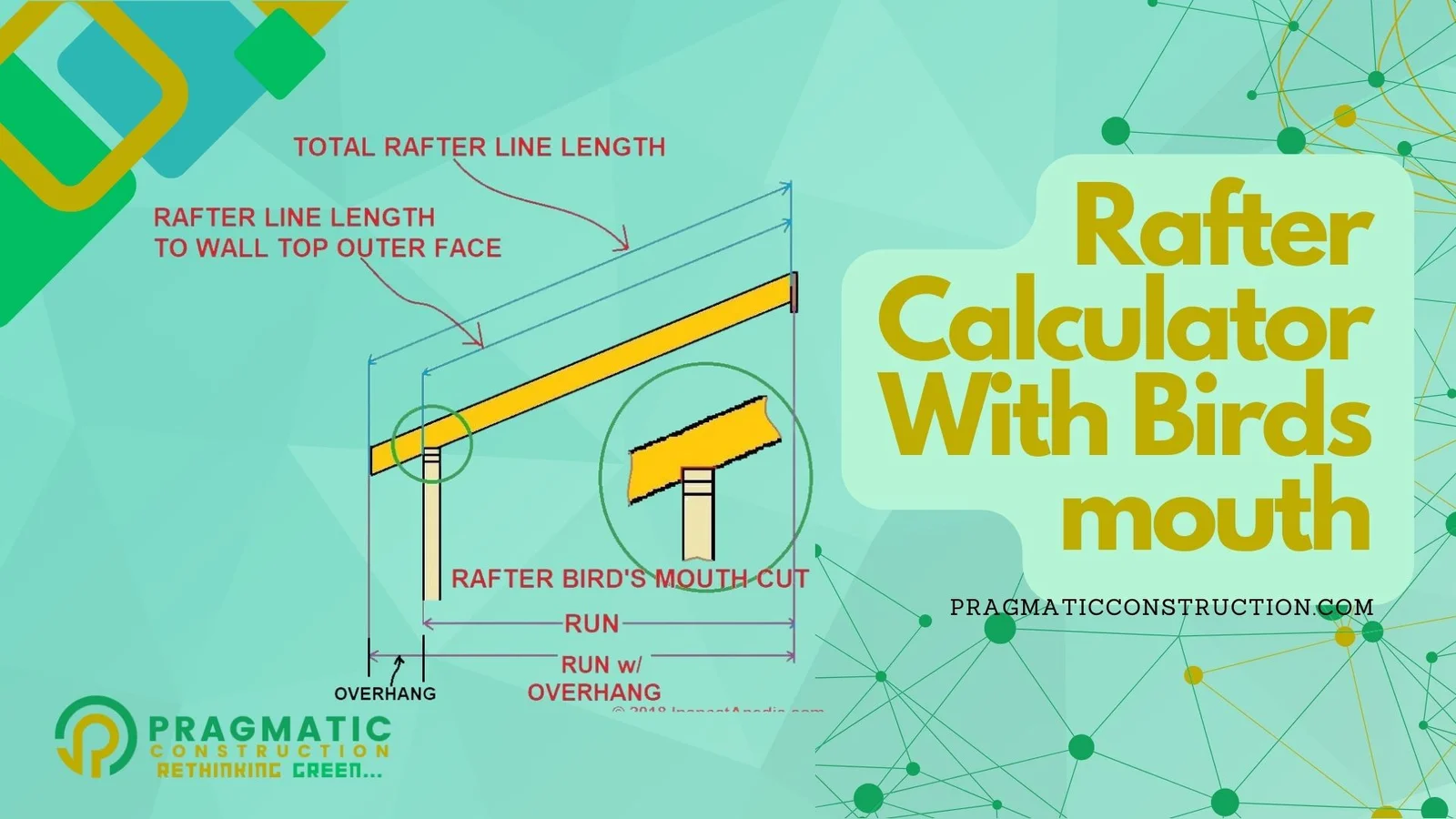Birdsmouth rafters play a crucial role in roof construction, providing stability and support to the overall structure. These specialized rafters are designed to bear the weight of the roof while ensuring proper alignment and distribution of forces.
Our rafter calculator with Birdsmouth and Seat Cut; helps you compute several additional elements compared to the initial rafter calculator. It encompasses calculations for the rafter’s run and rise, the distance from the top of the rafter to the plumb line, the overall length of the rafter, the height above the plate (HAP), the elevation of the ridge above the top plate, the support provided by the ridge board (beam), and to finalize the birdsmouth, it determines the length of the seat cut.
Beside the calculator, we’ll also delve into what birdsmouth rafters are, how to cut them, methods for measuring rafters, and considerations for determining the ideal rafter depth.

Rafter In General
A rafter, categorized as a type of sloped structural element, forms part of a series of such members extending from the ridge or hip to the wall plate, downslope perimeter, or eave. Its primary function is to provide support to the roof structure.
This necessitates that rafter members possess greater depth or are made from higher-grade and different species of materials to cover the same distance. However, transitioning to 24-inch centers also reduces the number of required rafters by up to 50%.
Principal rafters, the largest components utilized on each side of the roof framework, are accompanied by smaller common rafters positioned between them.
Rafters can be engineered to accommodate various slope angles, while also serving as a foundation for insulation and an attic space.
What is a Birdsmouth Rafter?
A birdsmouth rafter, also known as a bird’s beak cut or a birds beak seat, is a key component in traditional roof framing. It’s a notch cut at the base of the rafter where it rests on the wall’s top plate. This notch allows the rafter to sit securely on the wall while maintaining a tight connection and distributing the roof load evenly onto the supporting structure below.
How to Cut a Birdsmouth Rafter:
Cutting a birdsmouth rafter requires precision and accuracy to ensure a proper fit and structural integrity. Here’s a step-by-step guide to cutting a birdsmouth rafter:
- Determine the Rafter Length: Measure the length of the rafter needed for your roof design, accounting for any overhangs or additional features.
- Mark the Rafter: Using a framing square or a speed square, mark the plumb cut and the birdsmouth notch on the rafter. The plumb cut determines the angle of the roof slope, while the birdsmouth notch provides the rafter’s bearing surface on the wall.
- Calculate the Birdsmouth Depth: The depth of the birdsmouth notch depends on the size of the rafter and the pitch of the roof. Typically, it ranges from one-third to one-half of the rafter’s depth. Refer to local building codes or consult with a structural engineer for specific requirements.
- Make the Cuts: Use a circular saw or a handsaw to make the plumb cut and the birdsmouth notch according to the marked lines. Take care to ensure straight, clean cuts for a precise fit.
- Test Fit: Once the cuts are made, test fit the rafter on the wall to ensure that it sits flush and level. Make any necessary adjustments to the notch or the plumb cut as needed.
- Secure the Rafter: Once satisfied with the fit, secure the rafter to the wall’s top plate using appropriate fasteners such as nails or screws. Ensure that the rafter is properly aligned and supported.
How to Measure a Rafter:
Measuring rafters accurately is essential for proper roof construction and framing. Here are the steps to measure a rafter effectively:
- Determine Roof Pitch: Measure the rise and run of the roof to determine the pitch angle. The pitch is usually expressed as a ratio, such as 4:12, indicating a four-inch rise for every twelve inches of horizontal run.
- Calculate Rafter Length: Use the roof pitch and the span of the roof to calculate the rafter length. You can use mathematical formulas or online rafter calculators for accurate measurements.
- Mark Rafter Plumb Cut: Using a framing square or a speed square, mark the plumb cut angle on the rafter based on the roof pitch. This cut determines the slope of the roof.
- Mark Birdsmouth Notch: Determine the location and depth of the birdsmouth notch based on the rafter size and pitch angle. Mark the notch accurately to ensure proper bearing on the wall.
- Double-Check Measurements: Before cutting the rafter, double-check all measurements and angles to ensure accuracy. Mistakes at this stage can lead to costly errors during construction.
Rafter Calculator
How Deep Should a Rafter Be?
The depth of a rafter, also known as its height or thickness, depends on several factors, including the span of the roof, the roof load, and the roof pitch. Here are some considerations for determining the ideal rafter depth:
- Span of the Roof: Longer spans require deeper rafters to support the weight of the roof and withstand structural loads. Consult with building codes or structural engineers to determine the minimum rafter depth based on the roof span.
- Roof Load: Consider the weight of the roofing materials, snow loads, and any additional loads such as solar panels or HVAC equipment. Deeper rafters can provide greater load-bearing capacity and structural stability.
- Roof Pitch: The pitch of the roof affects the design of the rafters and the overall roof structure. Steeper pitches may require deeper rafters to accommodate the increased slope and provide adequate support.
- Building Codes and Regulations: Local building codes often specify minimum requirements for rafter depth based on factors such as roof span, load conditions, and regional climate. Ensure compliance with relevant codes and regulations to meet safety standards.
The Bottom Line
In conclusion, birdsmouth rafters, when properly designed and installed, contribute to the strength, durability, and longevity of roof structures. By employing best practices in rafter construction and adhering to relevant guidelines, builders can create robust roof systems capable of withstanding various environmental conditions while providing reliable protection for the underlying structure.
















